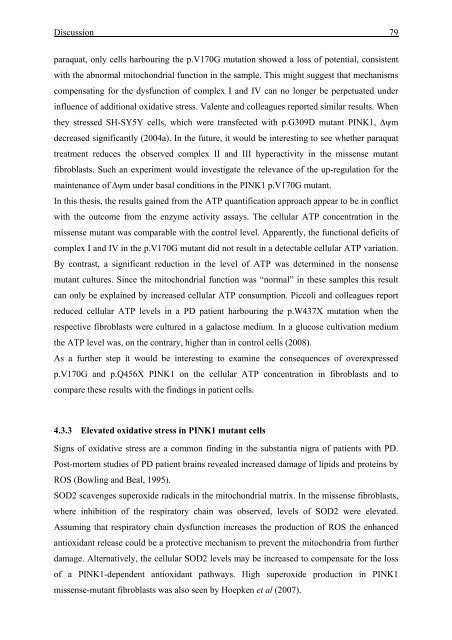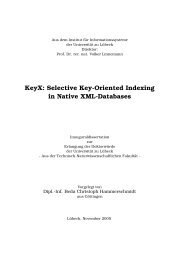Molecular characterisation of SGCE-associated myoclonus-dystonia ...
Molecular characterisation of SGCE-associated myoclonus-dystonia ...
Molecular characterisation of SGCE-associated myoclonus-dystonia ...
Create successful ePaper yourself
Turn your PDF publications into a flip-book with our unique Google optimized e-Paper software.
Discussion 79<br />
paraquat, only cells harbouring the p.V170G mutation showed a loss <strong>of</strong> potential, consistent<br />
with the abnormal mitochondrial function in the sample. This might suggest that mechanisms<br />
compensating for the dysfunction <strong>of</strong> complex I and IV can no longer be perpetuated under<br />
influence <strong>of</strong> additional oxidative stress. Valente and colleagues reported similar results. When<br />
they stressed SH-SY5Y cells, which were transfected with p.G309D mutant PINK1, ∆ψm<br />
decreased significantly (2004a). In the future, it would be interesting to see whether paraquat<br />
treatment reduces the observed complex II and III hyperactivity in the missense mutant<br />
fibroblasts. Such an experiment would investigate the relevance <strong>of</strong> the up-regulation for the<br />
maintenance <strong>of</strong> ∆ψm under basal conditions in the PINK1 p.V170G mutant.<br />
In this thesis, the results gained from the ATP quantification approach appear to be in conflict<br />
with the outcome from the enzyme activity assays. The cellular ATP concentration in the<br />
missense mutant was comparable with the control level. Apparently, the functional deficits <strong>of</strong><br />
complex I and IV in the p.V170G mutant did not result in a detectable cellular ATP variation.<br />
By contrast, a significant reduction in the level <strong>of</strong> ATP was determined in the nonsense<br />
mutant cultures. Since the mitochondrial function was “normal” in these samples this result<br />
can only be explained by increased cellular ATP consumption. Piccoli and colleagues report<br />
reduced cellular ATP levels in a PD patient harbouring the p.W437X mutation when the<br />
respective fibroblasts were cultured in a galactose medium. In a glucose cultivation medium<br />
the ATP level was, on the contrary, higher than in control cells (2008).<br />
As a further step it would be interesting to examine the consequences <strong>of</strong> overexpressed<br />
p.V170G and p.Q456X PINK1 on the cellular ATP concentration in fibroblasts and to<br />
compare these results with the findings in patient cells.<br />
4.3.3 Elevated oxidative stress in PINK1 mutant cells<br />
Signs <strong>of</strong> oxidative stress are a common finding in the substantia nigra <strong>of</strong> patients with PD.<br />
Post-mortem studies <strong>of</strong> PD patient brains revealed increased damage <strong>of</strong> lipids and proteins by<br />
ROS (Bowling and Beal, 1995).<br />
SOD2 scavenges superoxide radicals in the mitochondrial matrix. In the missense fibroblasts,<br />
where inhibition <strong>of</strong> the respiratory chain was observed, levels <strong>of</strong> SOD2 were elevated.<br />
Assuming that respiratory chain dysfunction increases the production <strong>of</strong> ROS the enhanced<br />
antioxidant release could be a protective mechanism to prevent the mitochondria from further<br />
damage. Alternatively, the cellular SOD2 levels may be increased to compensate for the loss<br />
<strong>of</strong> a PINK1-dependent antioxidant pathways. High superoxide production in PINK1<br />
missense-mutant fibroblasts was also seen by Hoepken et al (2007).

















